IJCRR - 13(9), May, 2021
Pages: 16-21
Date of Publication: 07-May-2021
Print Article
Download XML Download PDF
Specific Speed and Agility Drills to Improve the Performance of Field Hockey Players: An Experimental Study
Author: Neha Ingale Chaudhary, Muzahid Sheikh, Milind Kahile, Sachin Chaudhary, Vasant Gawande
Category: Healthcare
Abstract:Introduction: Field hockey is a popular sport across the world and is a national sport of India. The world of field hockey is constantly mounting, and thus a thorough analysis of skilled performance to evaluate its functionality is necessary. Many studies have stated the continuous wear and tear phenomena in structure and functions of the musculoskeletal systems and posture due to overload in the players.
Objective: This study focuses on improving the speed and agility of the players which eventually reduces the risk of injuries and thereby enhancing a better performance.
Methods: 20 professional male field hockey players aged 18-25 yrs. were purposively selected as potential participants for this study. All the subjects were evaluated using Illinois Agility Run Test, Hexagonal Obstacle Agility Test and Shuttle Run Test pre and 6 weeks post speed and agility training programme.
Results: The paired t-test was used to analyze the pre-post results which found to be significantly different, denoting that the time consumed for completion of the parametric tests was significantly improved (less time consuming) than that of before speed and agility training.
Conclusion: So, this study concludes that speed and agility training along with an effective exercise programme, improves the quality of the game in field hockey players.
Keywords: Speed agility training, Illinois Agility Run Test, Hexagonal Obstacle Agility Test, Shuttle Run Test, field hockey, Weave In – Weave Out, Box drill, Mini shuttle, Super shuttle, Slalom
Full Text:
INTRODUCTION
Field hockey is a popular sport across the world and is a national sport of India. The world of field hockey is constantly mounting, and thus a thorough analysis of skilled performance to evaluate its functionality is necessary. Many studies have stated the continuous wear and tear phenomena in structure and functions of the musculoskeletal systems and posture due to overload in the players. On grass, watered turf, artificial turf or synthetic ground, as well as indoors, the game can be played. Every team plays with ten players on the field and a goalkeeper. Sticks made of wood, carbon fibre, fibreglass, or a mixture is used by players. The hockey stick's length is dependent on the actual height of the player.1,2
Field hockey is a team sport to put the ball into the opponent’s goal using hockey sticks. A field hockey match consists of two halves during match and the team of 11 players who score more goals wins. Field hockey games are played outdoors, on a 91 × 55 m field covered with artificial grass. The goalkeeper and defenders protect their own goal; the forwards try to score goals and the midfielders create offensive actions and assist the defenders.3,4
A field player during a field hockey game runs an averagely of 10 km, maximum of which is by jogging or walking and only a shorter one is by sprints. The forwards are the fastest, and defenders are the slowest players. An average HR for a field hockey player is 135 bpm, and there are no significant differences in HR between the formations. The main technical elements of field hockey are dribbling, passing and shooting.1
Being able to run fast is not as effective as chasing faster the ball with a stick. Being able to turn and change direction is easier than doing it with a stick to chase the ball. Speed and agility training will provide improvement in the overall aspects of techniques of a field hockey player. Agility refers to the ability to quickly stop and re-start motion.
Agility is defined as an effective and quick coupling of braking, changing directions and accelerating again while maintaining motor control in either a vertical/horizontal direction.2 Speed is defined as the rate at which an object moves or how fast an object moves. Performance is defined as how you do something, how well you do it, and how much work you put into it.5
Agility is fundamentally important to sports performance for 3 reasons;
-
The injury risk decreases due to effective training of movement mechanics by agility and speed drills training.
-
The agility drills will enhance the proactive offensive and reactive defence mechanisms by swiftly altering the directions.
Speed training is a neuromuscular activity and thus requires athletes to perform these types of activities. Speed and Agility are two of the most important physical factors for a professional field hockey player to improve performance.6,7
NEED FOR THE STUDY
Due to repetitive use, the highly trained muscles become hyperactive and shortened.3 In the infield of hockey, the player needs to do adapt extensive postures such as bending sideways and forward, keeping one upper limb in external rotation and another in internal rotation. There are many ways to hit a ball in hockey such as scoop, drag-flick, drive, slap shot as well as push.1,3
International hockey is a highly competitive game. Winning and losing is a matter of the application of skills and hard work. It has been observed that the national team despite the great hard work has not been able to consistently maintain the top position in international hockey. There is a need to improve the basic and special skills. Many researchers have explained the role of repetitive strain and of overload-induced changes in field hockey players which caused various postural and structural as well as functional impairments in them.3-6 This study focuses on improving the speed and agility of the players which eventually reduces the risk of injuries and thereby enhancing a better performance.7
BIOMECHANICS
It focuses on 3 main areas:
-
Posture
-
Leg action
-
Arm action
Biological and biomechanical characteristics of field hockey
-
Due to alterations in the speed, the vital parameters do not significantly change in field hockey players.8
-
It requires a swift interchange of lumbar flexion, extension, side flexion, rotation, one arm in external and other in external rotation with consistent elbow flexion-extension interplay to pass shots in a variety of forms like flicks, drives, pushes, scoops, and slap shots.9
-
The characteristic and effective posturing is attained as of feet in stride standing and terminal flexion of the lumbar spine (Figure 1 and 2).10,11
These attainment pf postures on longer and repetitive period may cause high strain and overload on intervertebral discs, spine and pelvis structures. This results in micro-tears to annulus fibrosis with resultant changes in spine articulature.6,12,13
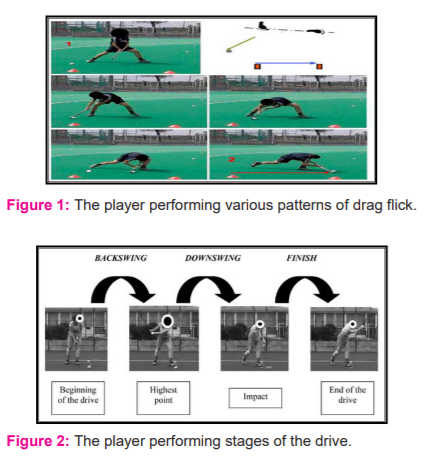
MATERIALS AND METHODS
The Experimental study aimed at examining the effect of Speed and Agility drills to improve the performance of field hockey players of the field hockey club Nagpur. with objective as to examine the effect of Speed and Agility drills to increase the speed and agility skills, to examine the effect of Speed and Agility drills to reduce the risk of injury and to examine the effect of Speed and Agility drills to improve the overall performance.
Information regarding the procedure was provided to each player. The due consent was taken. 20 professional male field hockey players (age 18-25 yrs.) without any history o injury or any systemic illness, were purposively selected as potential participants for this study. Each subject signed informed consent before taking part in the study.
All the subjects were evaluated using Illinois Agility Run Test, Hexagonal Obstacle Agility Test and Shuttle Run Test. The scores were documented as pre-test values. Materials used for the study were agility cones, a stopwatch and a hockey field. The study was conducted for 6 weeks (3 sessions/week).14
Procedure
All the players were asked to perform the Speed and Agility drills with clear explanations and brief instructions with initial 10 minutes of the warm up period. Post-test values of the Agility tests and Shuttle Run test are taken at the end of the 6th week and documented for statistical analysis. Initially, the players were introduced to a warm-up session of 15 minutes duration which involves;

This is followed by the Speed and Agility drills. The players end up the session with a cool-down period of 10 minutes.16
The drills are as follows:
-
Weave In – Weave Out
-
Box drill
-
Mini shuttle
-
Super shuttle
-
Slalom
Prescription:
-
Mode - Aerobic
-
Frequency - 3 sessions per week (with 1 set per day)
-
Repetitions - 3 times
-
Duration - 45 minutes (per day)
-
Intensity - Initially 25 seconds each drill on average (varies
according to individual’s ability).
Then gradually reduces.
Illinois Agility Run Test
Equipment Required ( Figure 4):
-
-
Flat nonslip surface
-
Marking cones
-
Stopwatch
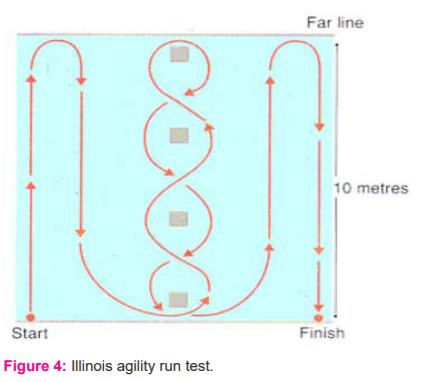
Procedure for illinois agility run test
-
The total length of the course is 10 meters and the distance between the start and finish points is 5 meters.
-
Four cones are used to denote the start, finish and each of the turning points.
-
Another four cones are placed down the centre equidistant from each other.
-
The distance between every two cones is 3.3 meters. The subject should stand in bent stride standing.
-
On the 'Go' command, and the athlete gets up and runs as fast as he can in the direction indicated, without knocking the cones over, to the finish line. The time from start to finish is recorded by stopwatch in seconds ( Table 1).
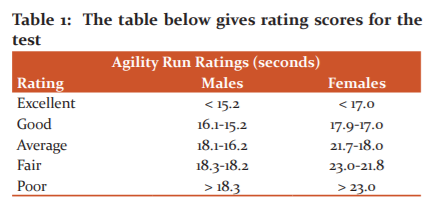
Hexagonal Obstacle Agility Test
Equipment Required:
-
-
Flat nonslip surface
-
Marking cones
-
Stopwatch
Procedure for hexagonal obstacle agility test:
-
The Hexagonal Obstacle Test is conducted as follows:
-
The athlete stands in the middle of the hexagon, facing line A at all times throughout the test the athlete is to face line A
-
On the command GO, the athlete jumps with both feet over line B and back to the middle, then over line C and back to the middle, then line D and so on.
-
When the athlete jumps over line A and back to the middle this counts as one circuit.
-
Three circuits should be completed without interval in between and the time recorded between the start and finish of the task in seconds ( Table 2 and figure 5).
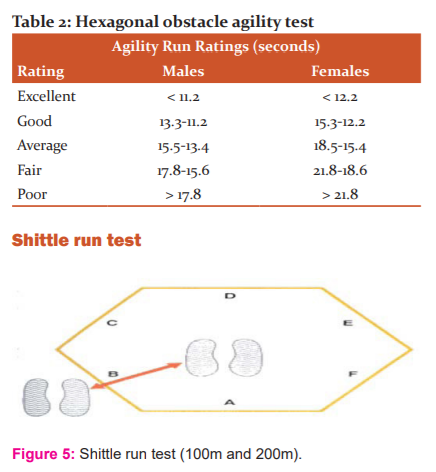
Equipment Required:
Procedure for shuttle run test:
-
The athlete is required to sprint from the starting line to pick up a block and then place it on the ground behind the starting line.
-
The athlete then sprints to pick up the second block and turns to sprint over the starting line ( Figure 5)
-
The stopwatch is started on the command "Go" and stopped when the athlete's chest crosses the line
-
An attempt is not counted if the block is dropped rather than placed on the floor. Also, the block must be placed behind and not on the line
-
Repeat the test 3 times Record the best time.
Speed and Agility Drills
Weave In – Weave Out 17
-
Place 4 markers/cones straight 3m apart.
-
Place another marker between each cone 3m to the left.
-
Sprint from one marker to the next and bend down to reach the cone with hands. Quick side steps should be taken (Figure 6).
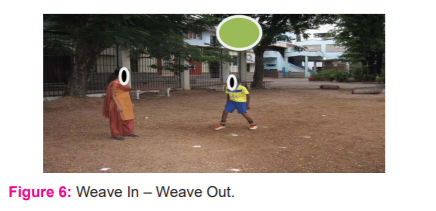
Box Drill:17
-
Use 4 cones/markers to mark out a square approximately 5m by 5m.
-
Place a cone in the centre of the square to start.
-
Each corner should be numbered.
-
Sprint to the corner named and return to the middle (Figure 7).
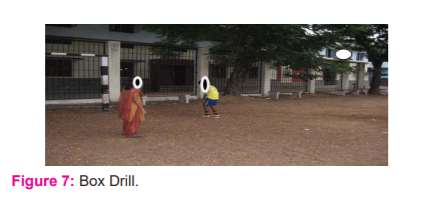
Mini Shuttle:17
-
2 markers/cones are placed 20m apart. Place a mark in the middle 3m to the side.
-
Starting from the middle marker sprint to one end (10m), turn and immediately sprint to the other end (20m) and then back to the start (10m).
-
Turn on a different foot at each marker and try to touch the ground with the hand (Figure 8).
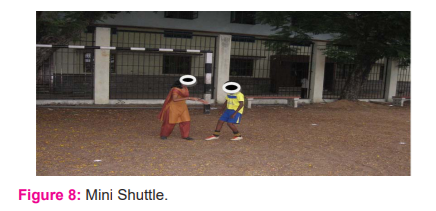
Super Shuttle:17
-
a series of cones are placed in a cross formation.
-
Run backwards to the centre cone, sidestep to the right cone, sidestep back to the centre cone still facing the same way.
-
At the centre, the cone turns and sprint forward to the end mark. Then run back to the centre cone, sidestep to the left, sidestep back to the centre, then turn and sprint back to the start ( Figure 9).
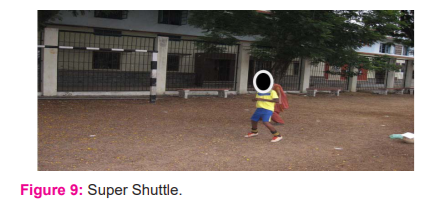
Slalom: 17
-
Place 10 shuttles in a line 5m apart.
-
Weave in and out as fast as possible and walk back to the start.
-
This drill is to improve speed ( Figure 10).
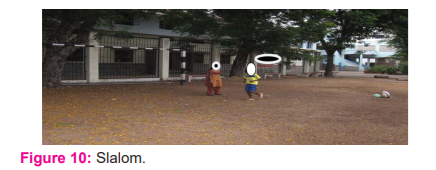
Paired t-test is used to compare the pre and post-test values of Agility tests and Speed tests.
RESULTS
In the Illinois agility run test, the comparison of the pre and post-training data was done. On application of paired t-test, with p <0.05, t=30.85, and 19 df, the time consumed for completion of the test were significantly reduced than the pre-test record (Table 3).
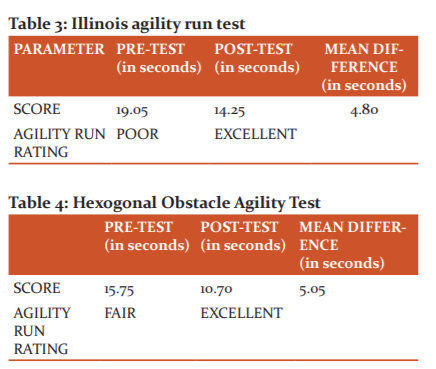
In the Hexagonal obstacle agility test, the comparison of the pre and post-training data was done. On application of paired t-test, with p <0.05, t=39.75, df=19, the time consumed for completion of the test was significantly reduced than the pre-test record (Table 4).

In the shuttle run test (100m), the comparison of the pre and post-training data was done. On application of paired t-test, with p <0.05, t=39.45, df=19, the time consumed for completion of test was significantly reduced than the pre-test record (Table 5).

In the shuttle run test (200m), the comparison of the pre and post-training data was done. On application of paired t-test, with p <0.05, t=32.23, df=19, the time consumed for completion of test was significantly reduced than the pre-test record (Table 6).
DISCUSSION
This study was done to evaluate the efficacy of speed and agility drills in field hockey players. The study reveals the significant difference after the drills. Thus the performance of the players is improved. After giving intense Speed and Agility training, the number of slow-twitch muscle fibres has been increased, thus delivering prolonged strength of contraction over many minutes to hours which directly decreases the risk of injury and enhance a better performance that makes the player faster.18 This is supported by the reviews of earlier authors.7,19
Also Azmiand Kusnanik in their study concluded that the speed, agility and quickness training program can improve the speed, agility and acceleration of the soccer players which supports this study.20 Few of the studies on physiotherapy and rehabilitation were reported21. Other related studies were reviewed. The effects of resistance and agility training significantly improve the agility performance of the school boy’s hockey players. The agility training would be better than the resistance training group and control group agility performance of school girl’s hockey players.18 Sharma et al. in their studies explained that the short term 6-week speed and agility training protocol also causes great improvement in performance which supports the current study.14 The study has various limitations such as small sample size, the other parameters such as strength, coordination improvement, ROM were not considered. Female participants were not included. Further studies should be carried out considering these parameters. Despite the limitations, the study highlights the importance short term of strength, agility, stretching and speed training on the field games, explaining the exact fabrication of training specific to the type of game.
CONCLUSION
This study concluded that administering short term Speed and Agility drills, improve the performance of field hockey players.
Conflict of interest: None
Source of Funding: None
References:
-
R Kaur, A Singh. Relationship of kinematical analysis and performance of scoop in hockey Int J Yog Hum Move Sport Sci 2019;4(1):1240-1243.
-
D Thakur, B Motimath. Flexibility and agility among children and adolescent athletes: an observational study. Int J Physiother Res 2014;2(4):653-656.
-
Kawa?ek K, Garsztka T. An analysis of muscle balance in professional field hockey players. Trends Sport Sci.2013;4(20):181-187.
-
Bartkowiak P, Lewandowski J, Szulc P. NMR evaluation of the injuries to the knee joint and vertebral column lumbar segment in field hockey players of the Polish national team. In: Jerzembowski J, Grzybiak M,Piontek J, eds., The Human is the Measure of All Things.Sopot: Tower Press 2006. 314-317.
-
Kawa?ek K, Garsztka T. A comparison of selected biomechanical parameters
In speed-endurance athletes. Trends Sport Sci. 2014; 2(21): 85-92.
-
Van G. The Effect of Acute Stretching on Agility Performance. J Strength Cond Res 2011;25(11):3014-3021.
-
Konarski J. Characteristics of chosen parameters of external and internal loads in Eastern European high-level field hockey players. J Hum Sport Exerc 2010;5(1):43-58.
-
De Subijana C. The application of biomechanics to penalty corner drag-flick training: A case study. J Sports Sci Med 2011; 10: 590-595.
-
De Subijana C. Training-induced changes in drag-flick technique in female field hockey players. Biol Sport 2012;29:263-268.
-
Zealand-Malawka E. Effects of prolonged sports training on the sagittal shape of the spine. Biol Sport 1989;6(3):255-260.
-
Ogurkowska MB. Pathological changes in lumbar-sacral intervertebral discs in professional rowers. Biol Sport 2007;24(4):375-388.
-
Sharma HB, Kailashiya J. Effects of 6-Week Sprint-Strength and Agility Training on Body Composition, Cardiovascular, and Physiological Parameters of Male Field Hockey Players. J Strength Cond Res 2018;32(4):894-901.
-
Gray S. Effect of active warm-up on metabolism before and during intense dynamic exercise. Med Sci Sports Exerc 2002;34:2091–2096.
-
Jaggers, J. The acute effects of dynamic and ballistic stretching on vertical jump height, force, and power. J Strength Cond Res 2008;22:1844–1849.
-
The content is Archived from- https://memorialhermann.org/services/specialties/ironman-sports-medicine-institute/sports-science-tips/tips-for-soccer-players/soccer-drills-for-agility
-
Wali K. Effect of resistance and agility training on performance of hockey players. Int J Phy Educ Sports Health 2017;4(1):131-132.
-
Sheppard J. Agility Literature Review: Classifications, Training and Testing. J Sports Sci 2006;24:919-932.
-
K Azmi. Effect of Exercise Program Speed, Agility, and Quickness (SAQ) in Improving Speed, Agility, and Acceleration. J Phys Conf Ser 2018;947:012043.
-
Panchbudhe S. Role of Physiotherapist to Promote Physical Activity in Physical Therapy Settings: Questionnaire Study. Int J Curr Res Rev 2020;12(14):50–55.
-
Risaldar P. Impact of Physiotherapy Rehabilitation Program on Postoperative Acl Tear Patient on Prognosis Leading to Maintain Consistency in Sport. Int J Res Pharma Sci 2020;11(3):4821–4825.
-
Sathe S. To Compare the Effects of Maitland Mobilization with Conventional Physiotherapy in Adhesive Capsulitis. Int J Curr Res Rev 2020;12(14):99–102.
|






 This work is licensed under a Creative Commons Attribution-NonCommercial 4.0 International License
This work is licensed under a Creative Commons Attribution-NonCommercial 4.0 International License